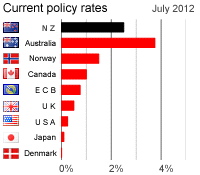 The US Federal Reserve has cut the Federal Funds Rate by 0.5% to a 50 year low of 1% to try to revive a US economy that is threatening to fall into its worst recession since World War 2. The Dow initially fell as some investors had hoped for a bigger cut, but rebounded in late trade on expectations it may boost economic growth and corporate profits.
The Fed Funds Rate is a key interest rate in the global financial system, acting as the base for many interest rate markets and being a major factor driving the world's biggest economy, although credit turmoil of late means that many US businesses and consumers are paying interest rates much higher than the Fed Funds Rate. The key 30 year mortgage rate remains over 6%.
The last time the Fed Funds rate was this low was in 2003 after the post-9/11 recession, although some argue the low Fed Funds Rate then was partly responsible for the explosion of cheap derivatives-fuelled lending that fuelled the housing boom and is now busting with such devastating effects across the world's financial system.
Norway's central bank also cut its official rate to 4.75% from 5.25%, while China cut its benchmark 1 year rate overnight to 6.66% from 6.93%, its third cut in two months. China's annual GDP growth rate has fallen below the 10% widely seen as required to keep soaking up its workforce. The Bank of Japan is expected to halve its official rate from 0.5% to 0.25% tomorrow to boost its economy, the world's second largest, which is being doubly hit by the Chinese and US slowdowns, and a strong Yen.
See the Federal Reserve Open Market Committee's full comments about the rate cut below.
The US Federal Reserve has cut the Federal Funds Rate by 0.5% to a 50 year low of 1% to try to revive a US economy that is threatening to fall into its worst recession since World War 2. The Dow initially fell as some investors had hoped for a bigger cut, but rebounded in late trade on expectations it may boost economic growth and corporate profits.
The Fed Funds Rate is a key interest rate in the global financial system, acting as the base for many interest rate markets and being a major factor driving the world's biggest economy, although credit turmoil of late means that many US businesses and consumers are paying interest rates much higher than the Fed Funds Rate. The key 30 year mortgage rate remains over 6%.
The last time the Fed Funds rate was this low was in 2003 after the post-9/11 recession, although some argue the low Fed Funds Rate then was partly responsible for the explosion of cheap derivatives-fuelled lending that fuelled the housing boom and is now busting with such devastating effects across the world's financial system.
Norway's central bank also cut its official rate to 4.75% from 5.25%, while China cut its benchmark 1 year rate overnight to 6.66% from 6.93%, its third cut in two months. China's annual GDP growth rate has fallen below the 10% widely seen as required to keep soaking up its workforce. The Bank of Japan is expected to halve its official rate from 0.5% to 0.25% tomorrow to boost its economy, the world's second largest, which is being doubly hit by the Chinese and US slowdowns, and a strong Yen.
See the Federal Reserve Open Market Committee's full comments about the rate cut below.
The Federal Open Market Committee decided today to lower its target for the federal funds rate 50 basis points to 1 percent. The pace of economic activity appears to have slowed markedly, owing importantly to a decline in consumer expenditures. Business equipment spending and industrial production have weakened in recent months, and slowing economic activity in many foreign economies is damping the prospects for U.S. exports. Moreover, the intensification of financial market turmoil is likely to exert additional restraint on spending, partly by further reducing the ability of households and businesses to obtain credit. In light of the declines in the prices of energy and other commodities and the weaker prospects for economic activity, the Committee expects inflation to moderate in coming quarters to levels consistent with price stability. Recent policy actions, including today's rate reduction, coordinated interest rate cuts by central banks, extraordinary liquidity measures, and official steps to strengthen financial systems, should help over time to improve credit conditions and promote a return to moderate economic growth. Nevertheless, downside risks to growth remain. The Committee will monitor economic and financial developments carefully and will act as needed to promote sustainable economic growth and price stability.

We welcome your comments below. If you are not already registered, please register to comment
Remember we welcome robust, respectful and insightful debate. We don't welcome abusive or defamatory comments and will de-register those repeatedly making such comments. Our current comment policy is here.